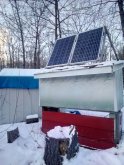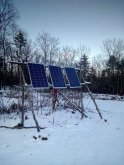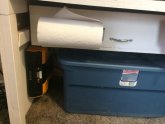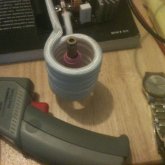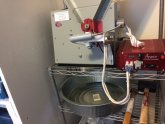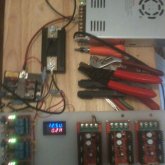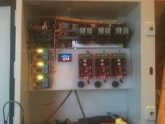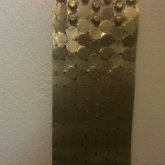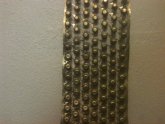Looks like I screwed up when I added a little bit of sulphuric acid to the batteries ...
https://www.crownbattery.com/news/watering-your-lead-acid-battery-the-basics
Yup.
The sulfur is still in the battery, stuck to the plates.
You added more sulfur, the liquid (electrolyte) is already saturated, which is why you got sulfur stuck to plates when the oxygen/hydrogen (water) split and became gas, left the cell and the sulfur behind stuck to the plates.
Adding distilled water would have allowed room for solid sulfur to go back into solution (desulfidatin cycle), but now that sulfur has no where to go and won't come off the plates.
The electrolyte can't absorb any more sulfur, and you added extra sulfur, the electrolyte is beyond 100% saturation or sulfur wouldn't have hardened on the plates to begin with.
Battery 'Electrolyte' (commonly called 'Acid', but not entirely acid) is usually at 99% saturation when it goes in the cells...
What comes out is well over 99% oxygen/hydrogen with some small traces of sulfur.
The vast majority of sulfur never leaves the battery, all it needs is CLEAN water and a good charge to put the sulfur back in suspension.
'Human' Clean, and Battery Clean are two entirely different things.
Humans tolerate dissolved solids, salts, chemical bases, etc quite well,
Humans are one way pass systems, 'Open Circuits', or 'Total Loss' systems, how ever you want to look at it,
Humans have a collection & disposal of waste/impurities systems.
Batteries are a CLOSED LOOP, if it goes in, it stays in.
Chemical Base (hard water) neutralizes acids on contact, and forever.
Not only that, but the calcium residue plugs up the pours in the lead paste reducing the porosity,
Nucleation can't take place, the output is drastically reduced.
(Just like when sulfidation plugs pours in the paste)
The batteries will hold charge, but they are very difficult to charge, and reasonable discharge is impossible.
With 'Tap' water, it's chlorine.
Acid & chlorine do not get along at all, and there is no reversing the chemical reaction.
Water softeners replace crud, mostly metals you can taste, with salt/salt ions, and again the battery goes down hill FAST!
Even rain water picks up crud of all kinds as it condenses and falls through atmosphere, while perfectly 'Safe' for humans since it doesn't pick up pathogens or enough solids/chemicals to harm humans,
It's not so with batteries, from ionization to carbon to sulfides, it's a really bad idea.
The same is true with bottled 'Drinking' water.
If you have a close look, it's either tap water, 'Spring' water (raw ground water with minerals) and they USUALLY have salts & minerals added for 'Taste'...
Deionized water is *Supposed* to be "Ideal" and what the battery companies use to dilute the electrolyte base.
What the engineers told me (not having a PhD in chemistry I can't conclusively prove), is deionized water actually ATTRACTS the electrolyte through an ionization process.
I use deionized water in some metal plating processes, and the PRICE is a factor!
About $25 a gallon in single gallons jugs...
The 'Second Best' is distilled water, while not deionized, it will accept the sulfidation readily when the ionization from a desulfidatin charge hits it.
The desulfidation charge is literally 'super charging' the ionization/transfer process, making the sulfidation jump to the electrolyte.
It's described as 'Blowing' the sulfur off the plates, the same way people say you get 'Blown' out of airplanes,
But it's more accurate to say they are 'Sucked' out,
And the sulfur is dissolved and 'Sucked' off the plates.
This is where balancing the desulfidation charge comes in,
Over charge, the plates expand and the sulfur cracks off the plates, with no charge it remains a solid and lands in the bottom of the case.
In the bottom of the case, it doesn't do you one bit of good!
While I see videos on rehab & desulfidation of batteries, they almost ALWAYS overcharge and get big bubbles, lots of heat...
Tiny bubbles you can't hardly see, looks more like cloudy electrolyte than bubbles, and a slightly warm battery FOR A LONGER PERIOD is better...
A 'blast' charge, hot batteries, and bubbles so big they blow electrolyte up onto the battery top are clear signs the charge being forced into the battery (remember, desulfidation charges don't 'Float' or back down!).
-------
What *CAN* and *CAN'T* be rehabbed...
If you see straight plates with the sulfur all the way to the top of the plates...
Good candidate for rehab.
Straight plates means no warping from heat/overcharging, plates being wedged apart by sulfur buildup.
They will probably still have *some* electrolyte circulation so the added water/electrolyte can get to the sulfur build up.
Seriously warped plates (shorted, sulfur wedging plates apart/together)
And sulfur starting 1/2" or more down the plates from the top,
That's a battery that was run with low electrolyte, poor to no chance of rehab.
The very top of the plates are supported by their respective 'Busses' (called Bridges) and being soldered on, they don't move much.
If the force of heat warp or sulfur bends the TOP, supported parts of the plates, there is a 99% chance the unsupported parts of the plates (much weaker) are broken or shorted out.
Never drain the battery, never turn it on its side, never add anything but distilled or deionized water.
Draining or turning on its side will bring everything up from the bottom 'Mud Tray' and wedge it in the plates.
This isn't just the general crud carried in with water, it's sulfur that cracked off the plates, and if the battery was worked really hard, it's CONDUCTIVE pieces of lead/lead paste that cracked off the plates.
Really high quality batteries have a plate separator, a piece of strip material that zig-zags top to bottom between plates, but still allows electrolyte to pass through.
It's function is to keep even warped/broken plates from touching.
The bad news is, every 'Down' fold is holding everything that came off the plate, if you tilt/dump the battery, the crud comes out of that fold directly into the plates/bridges...
I will use deionized water in good candidates...
It speeds the process SAFELY, and gives the best chance of rehab.
If the battery is questionable, no sense in spending the money.
$25 a gallon on a questionable battery you KNOW was abused since plates are warped, and you KNOW it was run dry... Like betting the bankroll on a cow in a horse race...
It's your money to do with what your want if you want to prove it to yourself.
Otherwise it's nothing but distilled water for maintenance refilling.
Low water, and DRY PLATE TOPS are two entirely different things!
If you use a flashlight (NO MATCHES!

) You will see a plastic collar that sticks down into the cell.
That collar will have a slot in the side somewhere.
The exact 'Perfect' electrolyte level is EXACTLY the bottom of that plastic collar, electrolyte just touching it.
*I* don't use an insulin syringe to fill my batteries, or an eye dropper either...
I'm NEVER 'Perfect' (and the batteries don't come from the factory 'Perfect' either).
Anything in the lower 1/2 of that tube is fine.
Below tube-- Add.
Complete full, suck some out and dispose of carefully.
Anything in the lower 1/2 of the tube, just fine, still air space at the top of the cell, and the slot (vent) isn't blocked, you are golden.
I keep 2 or 3 dollar store plastic turkey basters for filling, beats screwing with a funnel and they usually fit in the neck of a gallon jug (where they hang and plug the jug when not in use at my house).
Funnels don't let you see how much you are getting into the cell, turkey basters do.
It's up to you guys, I learned all this the hard ($$$) way, use it if you can...



